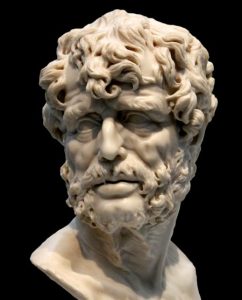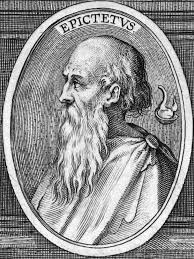By Donald Robertson, author of How to Think Like a Roman Emperor: The Stoic Philosophy of Marcus Aurelius, discusses strategies for coping with pain derived from the ancient wisdom of Stoicism.
We know that Marcus suffered from chronic chest and stomach pains, problems sleeping, and poor appetite, among other symptoms. While it’s not clear what illness he suffered from, modern scholars have speculated he may have been describing the symptoms of stomach ulcers, among other things. Curiously, the historian Cassius Dio praises Marcus Aurelius for the remarkable physical resilience that he showed despite being “extremely frail in body”.
He did not meet with the good fortune that he deserved, for he was not strong in body and was involved in a multitude of troubles throughout practically his entire reign. But for my part, I admire him all the more for this very reason, that amid unusual and extraordinary difficulties he both survived himself and preserved the empire.
- Carefully distinguish what’s directly under your control from what isn’t. This is really the basis of the Stoic approach. The Stoic philosopher Epictetus said: “What, then, is to be done? To make the best of what is in our power, and take the rest as it naturally happens.” That became the basis of the Serenity Prayer made famous by Alcoholics Anonymous: “God grant me the serenity to accept the things I cannot change; courage to change the things I can; and wisdom to know the difference.” Marcus likewise tells himself, “It is necessary that those who wish to follow Nature and be of one mind with her should also adopt a neutral attitude” toward things like pain and illness, by accepting the sensations and focusing instead on their own response to suffering (9.1).
- Compare the consequences of struggling versus acceptance. The Stoics liked to say that it’s not really pain that’s our problem but rather the fear of pain. Struggling against things we can’t change can add to our emotional suffering. They want us to learn a healthy and rational attitude of acceptance instead. Of course, if there are practical steps that could potentially help your condition then take them. However, Marcus reminds himself, in vivid terms, of the futility of struggling against suffering that is beyond our direct control: “Imagine every man who is grieved at anything or discontented to be like a pig which is sacrificed and kicks and screams” (10.28). We commonly intensify our emotional suffering by struggling against events in futile ways and growing frustrated with life.
- Remember that it’s not events that upset us but our judgements about them. This ancient Stoic doctrine became the fundamental premise of modern cognitive therapy. Pain and illness are unpleasant but you add another layer of suffering when you allow yourself to indulge too much in negative thinking about your condition. We can learn a great deal from those admirable individuals who are able to view physical illness more constructively. Marcus says that we should remember that unpleasant physical sensations, such as pain, are natural and inevitable in life, but that our conscious mind should not, “add to the sensation the opinion that it is either good or bad” (5.26).
Take away thy opinion, and then there is taken away the complaint, “I have been harmed.” Take away the complaint, “I have been harmed,” and the harm is taken away. (4.7)
- Practice letting go of the inner struggle and actively accepting painful sensations. The Stoics compared life to a dog tied to a moving cart. If the dog tries to struggle and resist it will be pulled along roughly by the cart anyway. However, if it chooses to run behind at the same speed as the cart, things will go smoothly. If we struggle against unpleasant experiences such as pain and try to resist them or become frustrated or resentful toward them then we often just make our lives worse.
- Contemplate how others cope well with pain and illness and model their attitude and behavior. Marcus must have seen countless examples of others coping with pain and illness throughout his life during the plague and wars that afflicted the empire. Some people cope with such adversity better than others, of course. The Stoics advise us to learn from the example of those who face adversity with wisdom and courage, and emulate their behavior.
Nothing happens to any man which he is not formed by nature to bear. The same things happen to another person, and either because he does not notice that they have happened, or because he wants to show off his strength of character, he is firm and remains unharmed. (5.18)One of the Stoics’ favorite strategies is to ask what virtue, or resource, nature has given us to cope with a challenge such as facing chronic pain or illness. Contemplating the example set by others is one way of reminding ourselves of potential strengths and coping resources that we already possess.
If you want to learn more about the life and Stoic philosophy of Marcus Aurelius, and how techniques from Stoicism can help you to deal with bad habits, manage anger, overcome worry and anxiety, cope with pain and illness, and even come to terms with your own mortality, check out How to Think Like a Roman Emperor.














No comments
Trackbacks
Our apologies, you must be logged in to post a comment.